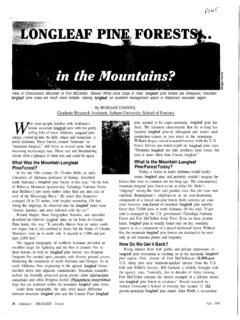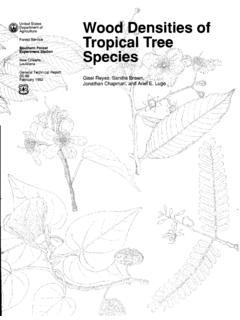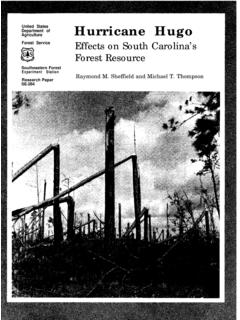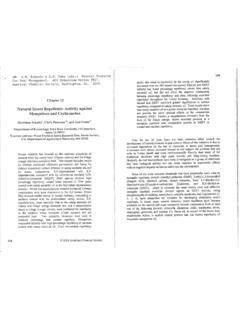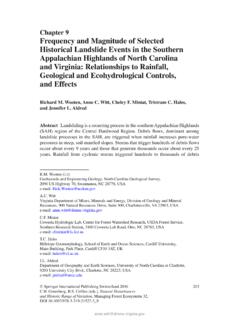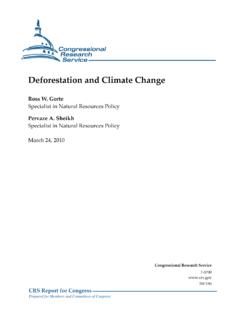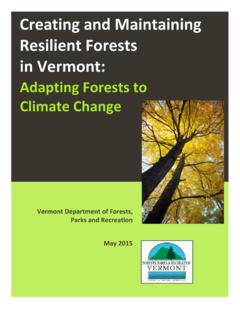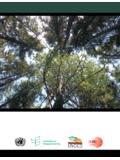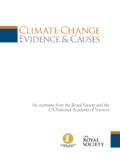Transcription of Forests (Chapter 17) of the Foundation document of Climate ...
1 489 CHAPTER 17 POTENTIAL CONSEQUENCES OF CLIMATEVARIABILITY AND change FOR THEFORESTS OF THE UNITED STATESL inda Joyce1,2, John Aber3,Steve McNulty1, Virginia Dale4,Andrew Hansen5,LloydIrland6,Ron Neilson1,and Kenneth Skog1 Contents ofthis ChapterChapter SummaryBackgroundClimate and ForestsKey IssuesForest ProcessesForests and DisturbanceBiodiversitySocioeconomic ImpactsAdaptations: forest Management Strategies under Climate ChangeCrucial Unknowns and Research NeedsLiterature CitedAcknowledgments1 USDA forest Service;2 Coordinating author for the National Assessment Synthesis Team;3 University of NewHampshire,4 Oak Ridge National Laboratory;5 Montana State University,6 The Irland Group490 Potential Consequences of Climate Variability and ChangeCHAPTER SUMMARYC ontextForests cover nearly one-third of the US,providingwildlife habitat,clean air and water,cultural and aes-thetic values,carbon storage,recreational opportuni-ties such as hiking,camping,fishing,and autumnleaf tours,and products that can be harvested suchas timber,pulpwood,fuelwood,wild game,ferns,mushrooms,and wealth depends onforest biodiversity the variety of plants,animals,and microbe species,and forest functioning waterflow, nutrient cycling,and of Forests are strongly influenced by climateand human land 17 / Foreststo predict.
2 Climate changes,changes in these distur-bances and their effects on Forests are of the results of ecological models whendriven by several different Climate scenarios indi-cate changes in the location and area of potentialhabitats for many tree species and plant example,alpine and subalpine habitats andthe variety of species dependent upon them arelikely to be greatly reduced in the conterminous ranges of some trees are likely to contract dra-matically in the US and largely shift into of potential habitats is possible foroak/hickory and oak/pine in the eastern US andPonderosa pine and arid woodland communities inthe well plant and animal species adaptto or move with changes in their potential habitat isstrongly influenced by their dispersal abilities andthe disturbances to these invasive species that disperse rapidly are likelyto find opportunities in newly forming effects of Climate change on socioeconomicbenefits obtained from Forests will likely be influ-enced greatly by future changes in human demands,as determined by population growth,increases inincome,changing human values.
3 And consumer recreation opportunities are very likely tobe altered by Climate example,warmerwaters would increase fish production and opportu-nities for some species;but decrease opportunitiesfor cold water recreation opportu-nities in mountainous areas are likely to be recreation opportunities are likely toexpand in the mountainous areas when warmerlowland temperatures attract more people to opportunities are likely bereduced with fewer cold days and snow Climate areas,the costs to maintain down-hill skiing opportunities are likely to rise whichwould possibly result in the closure of some FindingsCarbon storage in US Forests is currently estimatedto increase from to Pg of carbon per yearand analyses suggest that carbon dioxide fertiliza-tion and land use have influenced this current the next 50 years, forest productivity islikely to increase with the fertilizing effect of atmos-pheric carbon productivity increasesare very likely to be strongly tempered by local envi-ronmental conditions ( ,moisture stress,nutrientavailability)
4 And by human land use impacts such asforest fragmentation,increased atmospheric deposi-tion,and tropospheric analyses when driven by several differentclimate scenarios indicate an overall increase in for-est productivity in the US that is very likely toincrease timber inventory,subject to other more potential forest inventory to har-vest,the costs of wood and paper products to con-sumers are likely to decrease,as are the returns toowners of changes in Climate andconsequent impact on Forests are likely to changemarket incentives to harvest and plant trees,andshift land uses between agriculture and changes will likely vary within a incentives for forestry are likely to moderatesome of the Climate -induced decline in the area ofnatural trade in forest prod-ucts could either accentuate or dampen priceeffects in the US,depending on whether forest har-vest activity increases or decreases outside the the next century, changes in the severity,fre-quency,and extent of natural disturbances are possi-ble under future Climate changes innatural disturbances then impact forest structure,biodiversity,and of the resultsfrom Climate and ecological models suggest that theseasonal severity of fire hazard is likely to increaseby 10% over much of the US,with possibly largerincreases in the southeastern US and Alaska andactual decreases in the Northern Great the interactions between Climate changeand hurricanes,landslides,ice storms,wind storms,insects,disease,and introduced species are difficultThe remaining forestland is in various federal,state,county.
5 And municipal 50% of thefederal land in Forests is managed by the US largest state owner of forestland and municipal ownerships compriseless than 4% of the total , million acres of forestland are managed by theselocal governments in Minnesota 80% ofthe forestland in federal ownership is found in thewest,while most of the forestland held by states isin the northern part of the the 472 millionacres in private ownership,over 60% is found in theeastern part of the industry ownersaccount for 14% of the forestland in private owner-ship,and these lands are found mainly in the south-ern part of the US (54%). Forests are an environment in which people recre-ate,such as the National Forests and Parks,and anenvironment in which people live,such as the NewEngland woods,and the conifer Forests of provide recreational opportuni-ties such as hiking,camping,fishing,hunting,birdwatch ing,downhill and cross-country skiing,andautumn leaf addition,many rivers andstreams flowing through Forests provide fishing,boating,and swimming recreational associated with recreation provide incomeand employment in every forested region of the USand Canada (Watson et al.)
6 ,1998). Forests provideclean air and water, watershed and riparian buffers,moderate streamflow,and help to maintain York City s water supply is derivedfrom water collected within forested watersheds ina 2,000 square mile provide et al.(1999) report that at least 90%of the resident or common migrant vertebratespecies in the US rely on forest habitats for part oftheir life also provide culturaland aesthetic values,carbon storage,and productsthat can be harvested such as timber,pulpwood,fuelwood,wild game,edible plants,fruits and nuts,mushrooms,and floral wealth fromforests depends on forest biodiversity the varietyof plant and animal species and forest function-ing water flow, nutrient cycling and aspects of Forests are strongly influenced Consequences of Climate Variability and ChangeBACKGROUNDC overing nearly one-third of the US, Forests are anintegral part of the vegetative cover of the nation slandscape (Figure 1).
7 The total area in Forests in theUS is 747 million acres,which is about 7% of theforestland in the entire Forests are distrib-uted in the eastern and western parts of the US,with small stands of Forests in the central part locat-ed mainly along rivers and white-red-jack pine Forests of New England have supported atimber industry and the northeastern deciduousforests of maples,beeches,birches,and oaks providethe colorful autumn landscapes for region is rich in tree species from pineforests and coastal wetlands to northern uplandhardwoods such as oak-hickory and maple-beech-birch forest southern Forests are also amix of conifer and deciduous are primarily conifer Forests such as Douglas-fir, fir-spruce,Ponderosa pine and pi of forestland varies by region in the 63% of US forestland is in private Distribution of Forests in the United Statesdouglas-firhemlock-sitka spruceponderosa pinewestern white pinelodgepole pinelarchfir-spruceredwoodchaparralpinyo n-juniperwestern hardwoodsaspen-birchwhite-red-jack pinespuce-firlongleaf-slash pineloblolly-shortleaf pineoak-pineoak-hickoryoak-gum-cypressel m-ash-cottonwoodmaple-beech-birchaspen-b irchWestern ForestsEastern ForestsFigure 1.
8 Map of forest vegetation types for theUnited States. Map is from the USDA forest Service, SeeColor Plate AppendixPOTENTIAL CONSEQUENCES OF CLIMATEVARIABILITY AND change FOR THE Forests OF THE UNITED STATES492493 Chapter 17 / ForestsClimate change is one of several pressures onforests encompassed under the broader term, activities have altered the vegeta-tion distribution of Forests in the arrival ofEuropeans along the eastern coast initiated the har-vest of example,eastern white pineswere highly prized as ship masts for the EnglishNavy. From 1600 to the mid 1800s,the nativeforests in the eastern US were extensively harvestedfor wood products as well as to clear land for agri-culture and urban uses (Figure 2).While total forest -land area has stabilized in the US since the early1900s,land use shifts still occur where forestland isconverted to agricultural or urban use and agricul-tural or pasture is planted to some parts ofthe eastern US,new Forests have regrown on aban-doned agricultural lands,although forestland in thenortheastern part of the US is still less than 70% ofits original extent in the in theSouth occupies less then 60% of the 1600s extent offorestland,and the establishment of pine plantationshas placed some 20% of the forestland in this regionunder intensive western forestshave remained relatively constant in area since the1600s,recent expansion of urban areas and agricul-ture is fragmenting the Nation,urbanareas have continued to increase (Flather et al.)
9 ,1999).This expansion of human influences into therural landscape alters disturbance patterns associat-ed with fire,flooding,and addition,human activities can result in the dispersal of pollu-tants into atmospheric concen-trations of ozone and deposition of nitrogen (N)compounds have profound effects on tree photosyn-thesis,respiration,water relations,and activities modify the species composition offorests and the disturbance regimes associated suppression has altered southeastern,midwestern,and western meth-ods,such as clearcutting,shelterwood,or individualtree selection,have changed species composition innative average age of forest stands inthe East is less than the average for the West,reflect-ing the extensive harvesting as the eastern US management along with favorableclimates in parts of the US has resulted in highlyproductive Forests that are maintained for timberproduction,such as the southern pine and introduced insects and disease species,such as gypsy moth,chestnut blight,Dutch elm dis-ease,have altered US Forests (Ayres and Lombardero,2000).
10 Trees have been planted far outside their nat-ural ranges for aesthetic and landscaping purposesin urban and rural levels,economic growth,and personalpreferences influence the socio-economic valuesassociated with Forests ,and consequently theresources demanded from capita con-sumption of wood in the US has been relatively sta-ble over the last several decades and the futuredemand for wood products is projected to followpopulation growth over the next 50 development and consumer prefer-ences strongly affect the demand for specific woodand paper example,consumer prefer-ence has influenced the increasing amount of recy-cled material used in fiber over the last recreational hunting has been declin-ing,the economic impact is significant;Flather et al.(1999) estimated that,for all wildlife,hunters alonespent nearly 21 billion dollars on equipment andtravel in products harvested fromforests are more difficult to assign an economicvalue or to project future (1997)estimates the harvest of mushrooms fromWashington,Oregon,and Idaho Forests in 1992 to bevalued at about $40 2.
